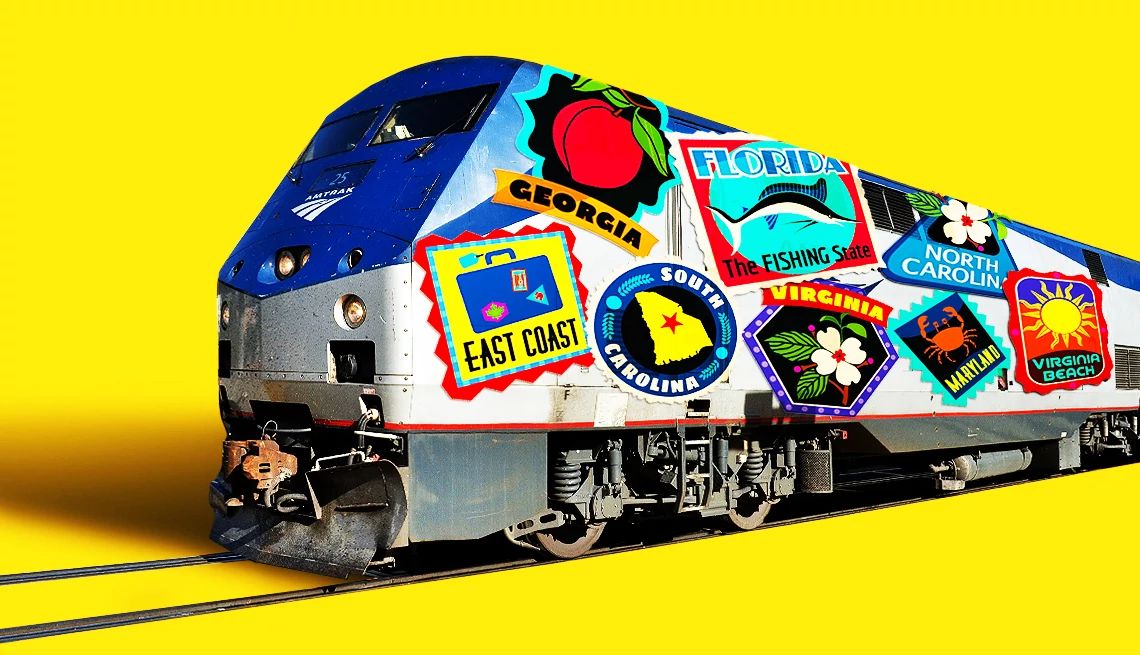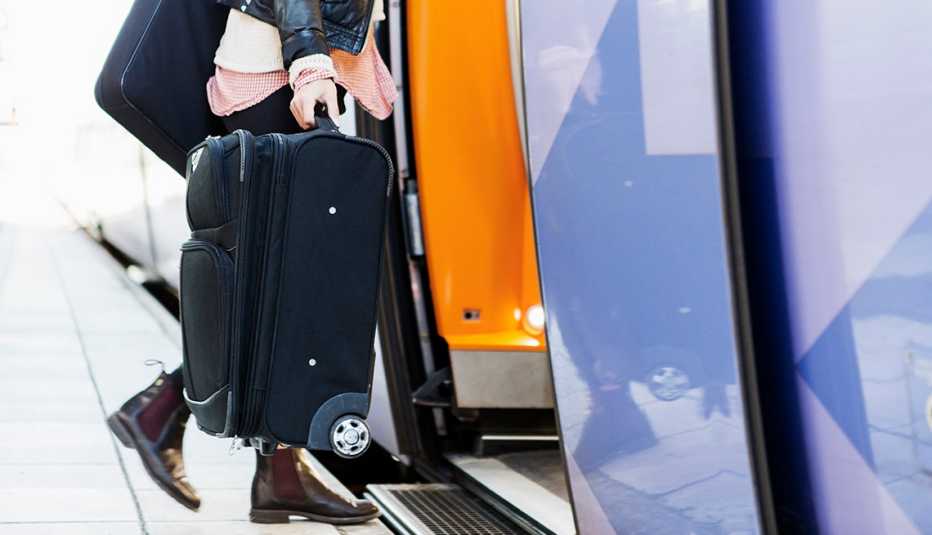AARP Hearing Center


In this story
Travelers may have plenty of ways to get from points A to B, but few modes of transit blend relaxation, efficiency and scenery like a train. The perks of train travel abound — including many discounts targeting those 50-plus — yet rail travel remains a tourism-industry underdog. We talked with leaders in the rail-travel industry for their tips and tricks. The result? Our Smart Guide to Train Travel, which will have you riding those rails like a pro. Note to readers: While this guide highlights top-level rail travel tips, it’s best to confirm details with your specific rail line or travel agent.


PLANNING YOUR TRIP
1. Book Early
Want to snag the best train-travel deals? “Book ahead for the cheapest prices, just as you would for air,” says Mark Smith, founder of the train-travel blog The Man in Seat 61. In Europe, the booking windows vary from 30 days to six months, depending on the operator. Benji Stawski, former senior reporter for The Points Guy travel website, notes that Amtrak’s booking schedule is a bit different. “Fares are released 11 months before departure, and often rise with demand,” he says. “Look out for any sales or promotions; Amtrak offers buy-one-get-one deals from time to time.”
2. Seek out discounts
Always check train-line websites for discounts before you book. For example, Amtrak offers a wide range of deals for children, seniors, military personnel and their families, military veterans, students, groups, passengers with disabilities, government employees and more. Amtrak also offers a 10 percent discount for seniors. Additionally, from late September to early May, the Alaska Railroad offers half-price fares for seniors 65 and older, Medicare cardholders and individuals with certain disabilities. Canada’s VIA Rail also runs special discounts throughout the year, including cost-saving options released every Tuesday. Finally, if you’re an AARP member, check out the discounts for rail travel. There are deals with Collette, Grand European Travel and Vacations by Rail.
3. Set up price alerts
Just like monitoring airline fares, you can track ticket prices for trains and receive fare-drop alerts via websites like Trainline and Train Price Tracker. According to Dan Reisig, communications manager at Railbookers Group, which operates Amtrak Vacations, the earlier you book, the better. “Not only do prices tend to be more favorable, but you’ll have the best availability for train and hotel accommodations,” Reisig says. That’s why many train lines also offer their own alerts when train tickets become available, including Rail Europe and the U.K.’s Transpennine Express and LNER.
4. More accessibility options
Many rail lines have made strides in offering accessible travel options. In the U.S., for example, Amtrak is increasingly improving the accessibility of its stations. In 2024, 17 stations came into compliance with the requirements of the Americans with Disabilities Act, and 40 more construction projects to improve mobility within stations are underway. Accessible tickets can be booked online or via the Amtrak app. These cover passengers who are deaf or have hearing loss; are blind or have reduced vision; are traveling with service animals; need room for a mobility device; or need an accessible seat. Travelers can also call 1-800-USA-RAIL (1-800-872-7245) for specific requests, including oxygen equipment, dietary restrictions or the use of a ramp or lift. Accessible room accommodations are also available for sleeper trains.
5. Best travel days
If your schedule is flexible, Stawski has some money-saving advice. “Business-heavy routes are pricier on weekdays,” he says. “Leisure routes might be more expensive on weekends. Likewise, you may be able to save money by booking less desirable departure times, such as late at night or in the middle of the day.” (Stawski adds that the day of the week you actually book the ticket doesn’t matter.)
6. Find low-crowd train cars
If you’re ready to get back into travel, but don’t love being around huge crowds, Amtrak spokesperson Kimberly Woods suggests you check out the company’s real-time seat availability tracker. “When searching for travel, the percentage of seats sold displays next to each trip option and adjusts as more reservations are made, which gives customers the opportunity to book a train that is less crowded,” Woods says. “If capacity exceeds comfort levels, customers can change their ticket without incurring a fee.” (She notes that a fare difference may apply.)
7. Earn points on train travel
You’re likely familiar with points and miles for air travel, but rewards-travel enthusiasts can also accumulate miles for train trips. “You can earn points on your trips through Amtrak’s loyalty program, Amtrak Guest Rewards. Then, you can redeem those points for free train tickets,” says Stawski, noting that this rewards program is free. Travelers earn two points for each $1 spent, as well as extra bonuses for bookings in first class. Like airline miles programs, travelers can also gain points by shopping through Amtrak’s guest-rewards program for everyday items such as flowers, Broadway shows and many other product categories. In 2024, Amtrak also introduced a new way to redeem points: Points & Cash, a program that lets travelers use not only points, but also a mix of points and dollars, to book their train travel. This switch makes it easier to redeem points quickly versus waiting to rack up enough for a train ticket. Rail lines abroad offer similar rewards programs, including VIA Preference for Canada’s VIA Rail, the China Railway Loyalty Programme on China’s MTR rail line, CartaFRECCIA on Italian train line Trenitalia and Club Eurostar for Europe’s Eurostar line.
8. Hire a train-travel agent
Booking an established route like Amtrak’s California Zephyr, between Chicago and San Francisco, is relatively straightforward — you visit Amtrak’s website or call Amtrak’s reservations team. But if you’d rather let an expert handle the logistics, or you want to concoct a DIY route with multiple legs, a travel agent may be a better option. Don’t just hire any agent, though, says Jim Loomis, author of All Aboard: The Complete North American Train Travel Guide. A simple test can ensure that the agent understands train travel. “I tell people to ask, ‘What’s the difference between a roomette in a Superliner train compared to a Viewliner train?’ ” he says. “The difference is that there is no window in the upper berth on the Superliner roomette. On the Viewliner, there is a window. A good travel agent [for train travel] will have the answer right off the top of their head.” One option Johnston suggests for U.S. train travel is Amtrak Vacations, an Amtrak-specific travel agency.
According to Jason Abrams, senior public relations manager for Amtrak, travelers can bring dogs and cats up to 20 pounds (this includes the weight of the pet carrier) for trips of up to seven hours as long as the pet stays in their crate. VIA Rail in Canada allows small dogs and cats in specific-sized carriers on the Corridor (Quebec City to Windsor) trains as well. That said, several Amtrak lines, including those in Canada, do not allow pets. Animals are also not allowed in sleeper cars or first class. Travelers with a disability can bring certified service dogs if needed.
10. Anticipate delays
Just like flying, train travel often comes with weather and congestion delays (particularly in the U.S., where Amtrak shares tracks with freight trains). That’s why Bob Johnston, a correspondent for Trains.com, suggests building extra time into your schedule. “Don’t assume a train will be on time; give yourself plenty of time [to catch a connection],” he says. “Let’s say the Lake Shore Limited gets into New York at 6:20 p.m. You don’t want to plan a Broadway show for that night.”



































































You Might Also Like
Train Travel Bucket List
If you love trains and want to visit national parks, we have five trips you should take
Ways to Save on Your Next Vacation
Travel industry pros share tips to help you keep costs down, without skimping on fun
Smart Guide to Cruises
We have tips on how to get great deals, selecting your cabin, planning where to dine and what shows to see and more
Recommended for You